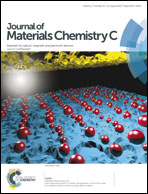Chitosan-based biopolysaccharide proton conductors for synaptic transistors on paper substrates
Abstract
Chitosan is a natural biopolymer and has been widely used for bio- and medical-materials. In this letter, with protonic acid doping, chitosan-based biopolysaccharide proton conductors were prepared with a high proton conductivity of 6 × 10−3 S cm−1 at room temperature and were first used for fabricating synaptic transistors on paper substrates. Based on the movement of protons with pulse voltage response within the chitosan dielectrics in a coplanar-gate transistor configuration, the paper synaptic transistors could be successfully used as artificial synapses for emulating biological synaptic functions. Short-term plasticity behaviors, including paired-pulse facilitation, dynamic filtering and spatiotemporally correlated signal processing were mimicked. Our results strongly demonstrate that these biopolysaccharide gating synaptic transistors proposed here are not only important for building cheap and biologically friendly artificial neuron networks, but also are interesting for realizing intelligent biomaterials.


 Please wait while we load your content...
Please wait while we load your content...